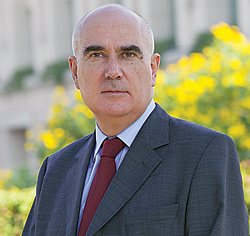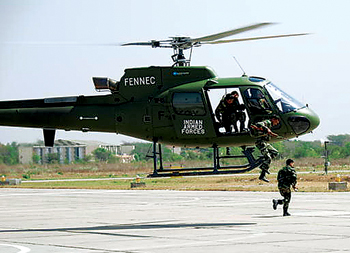INDIAN ARMED FORCES CHIEFS ON OUR RELENTLESS AND FOCUSED PUBLISHING EFFORTS

The insightful articles, inspiring narrations and analytical perspectives presented by the Editorial Team, establish an alluring connect with the reader. My compliments and best wishes to SP Guide Publications.

"Over the past 60 years, the growth of SP Guide Publications has mirrored the rising stature of Indian Navy. Its well-researched and informative magazines on Defence and Aerospace sector have served to shape an educated opinion of our military personnel, policy makers and the public alike. I wish SP's Publication team continued success, fair winds and following seas in all future endeavour!"

Since, its inception in 1964, SP Guide Publications has consistently demonstrated commitment to high-quality journalism in the aerospace and defence sectors, earning a well-deserved reputation as Asia's largest media house in this domain. I wish SP Guide Publications continued success in its pursuit of excellence.
- Indian Air Force Aims for Full Indigenous Inventory by 2047 — Air Chief Marshal A.P. Singh
- General Upendra Dwivedi takes over as the Chief of the Army Staff
- Rajnath Singh assumes charge as Defence Minister for the second consecutive term
- Admiral Dinesh K. Tripathi assumes Command of the Indian Navy as 26th Chief of the Naval Staff
- Prime Minister witnesses 'Bharat Shakti' – a Tri-Services Firing and Manoeuvre Exercise in Pokhran, Rajasthan
'For over 50 years, Airbus Group has supported the modernisation of the Indian armed forces and the development of indigenous capabilities'

Interview with Yves Guillaume, President India, Airbus Group
SP’s M.A.I. (SP’s): What are your views on the progress of the Indian defence industry so far and where do you see it heading in the future?
Yves Guillaume (Guillaume): Over the years stagnant or even shrinking defence budgets in the West have made Asia-Pacific and particularly India an attractive market for global defence firms. This represents an opportunity for the Indian defence industry, public and private, to partner with leading global players such as the Airbus Group and together work towards building a robust Indian militaryindustrial base. Such an approach will not only help modernise the Indian armed forces but will also bring cutting-edge technologies into the country and stimulate the Indian economy. A lot can be achieved as far as the modernisation of the Indian armed forces and indigenisation of technologies is concerned. Going forward, I expect this process to pick up more pace.
SP’s: Which open deals do you think the new government can bring to a conclusion quickly?
Guillaume: Let me give you some examples where Airbus Group is competing. The contract for six A330 multi-role tanker transport (MRTT) aircraft for the Indian Air Force is one. The negotiations are in the final stages and we look forward to concluding the contract with the Ministry of Defence in the near future. The acquisition is going to be absolutely transformative for the Indian Air Force and will put it in a select group of operators at the forefront of the current revolution in air-to-air refuelling.
The reconnaissance & surveillance helicopters (RSH) tender where Airbus Helicopters’ Fennec is competing is another example. Fennec is a single-engine helicopter offering unmatched hot and high altitude performance capabilities to the Indian armed forces. The new helicopters are supposed to replace the ageing Cheetah/Chetak fleet which is now depleting as it has been in service for over 50 years in India. Since the issue of the current request for proposal (RFP), till date, a total period of over five years has elapsed. This is the third time that the RFP has been issued for the same procurement, the first being in November 2003. We are fully committed to support this programme and hope that this acquisition process will soon be concluded by the Ministry of Defence.
SP’s: What are your views on India’s offsets, FDI and technology transfer policies for defence procurement?
 Guillaume: We fully support India’s policies regarding offsets and technology transfer which have been implemented to boost the country’s indigenous defence industry and safeguard its sovereignty. However, one must bear in mind that offset activity should be based on a sound business case. It has to be sustainable. Otherwise, it will not result in long-term meaningful benefits for the local industry. In India, the revised Defence Offset Guidelines issued in 2012 added certain new features such as ‘multipliers’ and modified/clarified some of the earlier provisions. The new guidelines provide foreign OEMs greater flexibility and incentive in meeting their offset obligations.
Guillaume: We fully support India’s policies regarding offsets and technology transfer which have been implemented to boost the country’s indigenous defence industry and safeguard its sovereignty. However, one must bear in mind that offset activity should be based on a sound business case. It has to be sustainable. Otherwise, it will not result in long-term meaningful benefits for the local industry. In India, the revised Defence Offset Guidelines issued in 2012 added certain new features such as ‘multipliers’ and modified/clarified some of the earlier provisions. The new guidelines provide foreign OEMs greater flexibility and incentive in meeting their offset obligations.
As for the 26 cent cap on foreign direct investment (FDI) in defence, we respect the law of the land. We have successfully worked and delivered results within the perimeter of the existing policy. However, if the cap is raised and we are allowed to form joint ventures where we have more management control, it will be easier for us to develop a larger industrial base here. A mechanism with sufficient checks and controls can be built into the policy so that India’s interests remain fully protected.
SP’s: What new opportunities in defence do you see for Airbus Group in India in 2014 and what are your expectations from the new government?
Guillaume: The opportunities are immense. Apart from the MRTT and RSH competitions where we expect forward movement, Airbus Defence and Space will soon respond to the request for proposals to replace the Avro medium transports with the modern C295 aircraft. This is a very important programme for us – covering 56 aircraft – but also for the Indian industry because of the excellent collaborative prospects that it offers.
For over 50 years, Airbus Group has supported the modernisation of the Indian armed forces and the development of indigenous capabilities. We look forward to further strengthen our partnership with India and expand our industrial footprint here. We are hopeful that the new government will accelerate the modernisation process, continue to reform the defence procurement procedures, and take steps to incentivise even greater cooperation between foreign OEMs and Indian companies.





